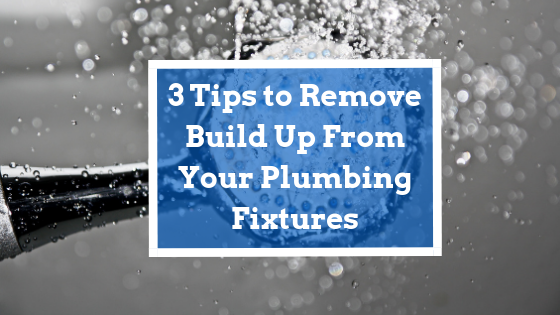What is that white residue that lingers on your plumbing fixtures and seems to never go completely away? It’s a product of the mineral content in your water supply and for most homeowners, it’s a daily fact of life.
Many people wonder: how do I remove calcium build up on my faucets? Do I need a whole house water filtration system? Should I consider water softeners?
First, let’s clean up those plumbing fixtures. Mineral deposit buildup occurs over time and involves a molecular bonding that makes the stains so hard to remove. The best cleaning solutions need a little time to soak in and break down the minerals so they can be wiped or rinsed away.
Tip #1 Professional All Purpose Homemade Cleaner: From Gunk to Glorious in 30 Minutes.
- Fill about half a spray bottle with distilled white vinegar.
- Add in ¼ cup of lemon juice.
- Fill the majority of the remaining space in your spray bottle with the dish soap of your choice.
- Shake the bottle to mix the ingredients thoroughly.
- Spray liberally on hard water stains. This solution can be used on everything from polished fixture finishes to rough faucets.
- Let it sit for 30 minutes. Go have a cup of tea.
- The grime should mostly be able to be wiped away or gently scrubbed off with a soft cloth. The bases of fixtures, where they meet the counter tops, may need scrubbing with an old toothbrush.
- Rinse thoroughly.
Tip # 2: Vinegar Power
Although vinegar generally takes longer to work, it is something you already have on hand and for lighter tasks, it can certainly get the job done. Distilled white vinegar is also safe on polished metal finishes and on bare skin.
- For those faucet bases that always seem to accumulate scaling, soak a small cotton rag or washcloth in a bowl of straight white vinegar. Wrap the cloth around the base so it is making full contact with every area that has scaling, including any area above the base where scaling has developed. Leave for at least an hour. When the time has passed, remove the cloth and scrub away the now-loose deposit with an old toothbrush. Doing this once every couple of months will make this job easy and keep your fixtures looking great.
- Almost all modern faucets and shower heads have screens at the very ends to filter out mineral deposits and other grit that may have been passed through the pipes. Over time, they all need cleaning to restore a healthy water flow. Faucet screens are easy to unscrew and should be soaked in white vinegar for at least two hours. Shower heads often have a removeable front but sometimes the entire head must be unthreaded. They should also be soaked in vinegar for a couple of hours.
Afterwards, faucet screens should be brushed to remove loose material, then rinsed and reinstalled. Before doing so, check their condition. Worn screen are easily and cheaply replaced at most hardware stores. Shower heads may still have debris in the openings and each hole should be cleared with a toothpick. It’s worth it! Your shower will feel like it’s new.
- Glass shower doors accumulate lime scale and hard water stains quickly. A weekly spray-down with white vinegar helps avoid build up and makes bathroom cleaning chores easier and faster. You can have a wonderfully clean bathroom, but a shower door is fogged with scaling is not a pleasant look.
- 3 cups of white vinegar in the tank should eliminate hard water stains and keep it out of the bowl. Adding 3 cups of vinegar to the water in the bowl and scrubbing is a good way to keep the bowl clean looking.
- Coffee maker. Fill once with white vinegar and run for a full cycle without paper filter (if a basket and drip model) to remove deposits. Then run two more cycles with plain water to rinse. If you supplement your water supply with bottled water, keep some distilled water on hand for these rinses.
- Adding a cup of white vinegar to a normal cleaning cycle (while dishwasher is empty) will help clean the screens and hoses of calcium deposits.
Tip #3: Prevention
If you have hard water and want to “clean” it of minerals, the only effective solution is to place a water softening system somewhere on your fresh water line. Some people install it only in the lines that run to the shower, tub and washing machine. Others soften the entire water system except for outside irrigation.
There is some rivalry between water filter and water softening companies and their claims can be confusing – which is best? The truth is that hard water minerals can wreak havoc on your fixtures and hot water heater and if you are living with hard water, you need to schedule regular maintenance. The minerals themselves are generally harmless. Water filters remove contaminants but not hard water minerals except in very high end systems. Both systems require periodic maintenance and filter replacement.
Preventing Mineral Buildup
Other common prevention methods for hard water homes include:
- Wiping down wet surfaces before they dry and leave mineral deposits.
- Keeping surfaces protected from water staining. There are spray on films often used on car windshields that can be used on glass shower doors that repel water and prevent spots.
- Frequently spraying down sinks and tubs with lemon juice or vinegar and let sit for a while before wiping clean.
- Liberally applying a paste of baking soda and white vinegar to problem areas where hard water accumulation is most chronic. Let it stand for a while and then rinse. This helps slow down the rate of staining and scaling and makes maintenance less frequently needed.


